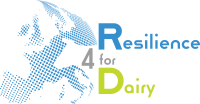Factsheets
A result of the R4D project is to collect solutions/innovations from the different countries and publish the most helpful ones for the future as factsheets. Those are divided in 3 main Knowledge Areas:
Economic and social resilience ![]()
Technical efficiency ![]()
Animal welfare, Environment and Society ![]()
Feel free to navigate through the factsheets and find the corresponding videos and webinars, as well:
https://view.genially.com/666ab42a5473290014564e11/presentation-r4darbre-decision
FILTER
| Knowledge Area | TITLE | DESCRIPTION | LANGUAGE | VIDEO | PDF DOWNLOAD |
|---|---|---|---|---|---|
| Biodiversity monitoring – A way to assess the impact of farming practices on ordinary biodiversity Environment Society friendly |
Across Europe multiple evaluation processes assess the impact of farming practices on ordinary biodiversity, using indirect indicators. Through an inventory of agricultural practices and agroecological structure, conclusions can be made on the impact of the farm on ordinary biodiversity. This allows for farmers to talk about biodiversity within a structured framework through the example of their farm. Within the dairy chain, tools are available to effectively use these processes to set up an action plan to preserve biodiversity on and around the farm. |  |
download | ||
| Biodiversity advisory and implementation package for dairy farms Environment Society friendly |
Biodiversity is crucial for both the planet and people, playing a key role in providing ecosystem services, regulation of the climate, pollination, maintaining soil health and adaptation to climate change. However, biodiversity is currently declining at an unparalleled rate, creating one of the most urgent environmental issues. |  |
download | ||
| Multispecies Swards (MSS) - using forage herbs for enhanced forage yield, nutrient uptake and biodiversity Environment Technical efficiency |
Multispecies swards are swards that have a variety of plants including grasses, legumes, brassicas and herbs. When combined in a pasture, the species root at varying depths allowing them to access more nutrients and moisture in the soil, promoting better soil health and increasing pasture biomass. The deep rooting depth of herb species, such as chicory and plantain, increases carbon sequestration and improve the drought tolerance of multispecies swards. In addition, diverse pastures help improve biodiversity, particularly pollinators, and can help to reduce nitrate loss from pasture via a lower nitrogen fertiliser requirement. |  |
download | ||
| Explore, align with stakeholders and develop opportunities to align with regional rural goals on biodiversity and water and farm management Economic resilience Social resilience |
Farmers are entrepreneurs that sometimes may feel that they are being managed in how to do their job as well as being piled under by rules and regulation. This may lead to growing displeasure, unhappiness and resistance amongst farmers at the expense of their relations with influencers, stakeholders, policy makers and society, who are often experiencing the same challenges. Approaches that encourage collaboration , discussion and working on perspectives that are carried more broadly can help to steer and reach multi stakeholders’ targets, wishes and desire s. One such approach is called in the Netherlands the ‘De Marke Model’. This model may serve as a basis, example or reference for similar approaches elsewhere. |  |
download | ||
| Maximizing forage performance to reduce concentrate feed - grass silage Economic resilience Technical efficiency |
Ruminants have a unique ability to convert fibrous feed materials into high quality milk and meat products thanks to the genius evolutionary development the rumen. The rumen harbours fibrolytic microbes that allow utilization of e g grass that is not directly human edible Grass cultivation provides many ecosystem services such as carbon sequestration, improved biodiversity, less erosion, capture of nutrients, better soil structure etc. Fibrous forages are natural feeds for ruminants and support the health of their digestive system. Typically grass based feeds are also cheaper than concentrate feeds. All these factors support high use of grass in the diets of ruminants, but it requires production of good quality grass based feeds. |  |
download | ||
| Red clover as a pure stand for silage can bring benefits Environment Technical efficiency |
Red clover (Trifolium pratense ) has many benefits, such as the ability to fix nitrogen thanks to the symbiotic Rhizobium bacteria in its root nodules, it improves biodiversity, and it has favourable characteristics as a feed component in ruminant diets. However, the persistency of red clover is poor in Boreal swards and the leys seldom last longer than two years. |  |
download | ||
| Management of hedges and marginal areas to improve biodiversity Economic resilience Environment Social resilience |
Hedgerows and marginal areas, such as field margins and road verges, are a typical landscape feature in many parts of Europe. They provide an important habitat for a variety of flora and fauna. However, increased agricultural intensification and associated land use changes over the past decades have led to a dramatic decrease in the biodiversity of hedgerows and marginal areas. |  |
download | ||
| Agroforestry on dairy farms Animal welfare Environment Society friendly |
For several decades, plots of land have been grouped together, and trees have been pulled down to facilitate the cultivation of agricultural land. Nowadays, some farmers are experimenting with planting trees/hedges within plots for various reasons: to provide shade for the animals, to create a microclimate favourable to grass growth, to increase biodiversity, to diversify production (e.g. orchards, wood chips as bedding material). |  |
download |
